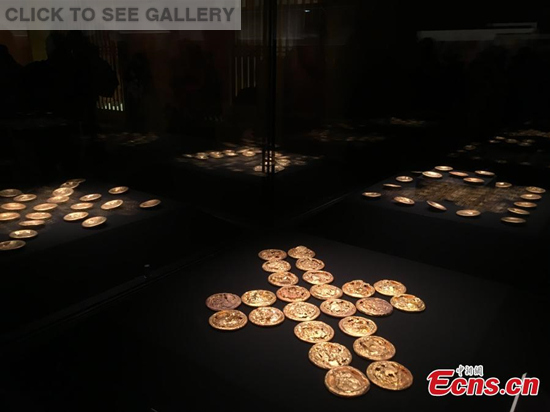Among the more than 10,000 artifacts unearthed so far from the 2,000-year-old tomb of Haihunhou, the Marquis of Haihun, are treasures of great historical values, said archeologists.
The tomb, which dates back to the Western Han Dynasty (206 BC - 24 AD), is the best-preserved tomb of that period ever found in China. It is the final resting place of Liu He, grandson of Emperor Wu, whose reign ushered in one of the most prosperous periods in China's history.
The following is a breakdown of the top discoverers. Some will be on display at Beijing's Capital Museum from Wednesday, the first time they will have been seen by the public.
MARQUIS SEAL
The tomb master is the Marquis, Liu He.
At the show in Beijing, relics from the interior coffin of the tomb are expected to be put on display for the first time. The most attractive one is likely to be the marquis' private seal, which was key to uncovering the identity of the tomb master.
Liu was given the title "Haihunhou" after he was deposed as emperor after only 27 days, dethroned by the royal clan over, what they said was, a lack of talent and morals. Haihun is the ancient name of a very small kingdom in north Jiangxi.
PORTRAIT OF CONFUCIUS
Archeologists pieced together a broken lacquer screen found in the main chamber of the tomb, which is a portrait of Confucius.
Text reading Confucius, the name of his pupil Yan Hui and the name of his father Sulianghe can all be deciphered on the screen.
The finding of the Confucius portrait in the marquis's tomb indicates Confucius' teachings were prevalent among the ruling class in the Western Han Dynasty.
The screen, however, is not among the items to be displayed, as it is too delicate.
CHARIOT BURIAL
Haihunhou Cemetery is in Nanchang, capital of Jiangxi Province. It covers some 40,000 square meters with eight tombs and a chariot burial site, with walls that stretch for almost 900 meters.
Archeologists discovered five well-preserved horse-drawn vehicles, each with four sacrificed horses, in the corridor of the main tomb of Haihunhou.
Vehicles with four horses indicates that the owner of the vehicle was among the highest echelons of the Han Dynasty.
More than 3,000 accessories embellished with gold and silver were also found.
Although the vehicles will not be included in the show, some of gold and silver accessories will be on display.
CHINA'S OLDEST DISTILLER?
A vessel believed to be a distiller with remains of taro, the raw material for Japanese saki, was also found.
Archeologists are still working to confirm whether the vessel was used for making liquor. If it is proven, it would push back China's history of making distilled spirit 1,000 years earlier. Currently there is evidence of the practice starting during the Yuan Dynasty (1271-1368).



















































